|
"The Lindenmeier site was discovered in 1924 by
three relic collectors, Judge C. Coffin, his son A. Lynn Coffin, and C.
K. Collins."--------1978,
Edwin N. Wilmsen & Frank H. H. Roberts, Jr., "Lindenmeier,
1934-1974, Concluding Report On Investigations." p. 1.
"The
importance of the Lindenmeier site lies in the fact that for the first
time, traces of an occupation level which can be assigned to a group of
Folsom men (and also women)
have been brought to light."----1935,
Frank H. H. Roberts, Jr., "A Folsom Complex, Preliminary Report On
Investigations At The Lindenmeier Site In Northern Colorado," p. 9.
"After the first discovery at Folsom, New Mexico
(the
Folsom type site, 1926)
efforts were made to find more of the distinctive grooved (fluted)
points, and further examples were found in private and museum
collections."---------1957,
H. M. Wormington, "Ancient Man In North America," p. 31.
"The rarity of perfect specimens (of
Folsom points) has been commented
upon in various articles on the subject of Folsom points."------1935,
Frank H. H. Roberts, Jr., "A Folsom Complex, Preliminary Report On
Investigations At The Lindenmeier Site In Northern Colorado," p. 17.
"The Lindenmeier site is in an unusual valley setting: a
low-order tributary of the Cache La Poudre River, which joins the South
Platte near the Klein and Powers sites. This tributary is in a small
valley isolated along the escarpment that forms the physiographic (physical
geographical) boundary of the
northern Colorado Piedmont and the High Plains"----2006,
Vance T. Holliday & Rolfe D. Mandel, "Geoarcheology Of The Plains,
Southwest, And Great Lakes," Handbook Of North American Indians,
Vol. 4 Environment, Origins, and Population (Smithsonian), p. 30.
"The
man-made material and animal bones (on
the Lindenmeir site) occur in a dark
soil layer which rests on the clay bed and underlies the conglomerate."----1935,
Frank H. H. Roberts, Jr., "A Folsom Complex, Preliminary Report On
Investigations At The Lindenmeier Site In Northern Colorado," p. 11.
"As a result of
their continued presence (on the
Lindenmeier site), numerous objects
associated with their daily round of life--charcoal and ashes from their
fires, bones from the animals that supplied the meat, broken tools and
other artifacts--were scattered over the surface."----1935,
Frank H. H. Roberts, Jr., "A Folsom Complex, Preliminary Report On
Investigations At The Lindenmeier Site In Northern Colorado," p. 11.

THE LINDENMEIER
FOLSOM SITE
12,900 TO 11,700 YEARS AGO
NORTHERN COLORADO
The Folsom type site was discovered before the
Lindenmeier site was discovered. But Lindenmeier is the site that provided the first unquestionable proof that
there was a Paleo-Indian period and that people were living in North
America at a much greater age than was previously thought. The
Folsom bison kill site produced Folsom points
that were in direct contact with extinct animal bones, but
archaeologists were still only cautiously interested. Frank Roberts wrote in
1935 about the 1927 American Anthropological Association meeting in
Andover, Massachusetts, saying that: "There was considerable discussion of the
subject (about the Folsom site),
and although many agreed that the discoveries were important, there was
still a general feeling of doubt (about the
antiquity of Folsom)." Lindenmeier
changed everything. |
|
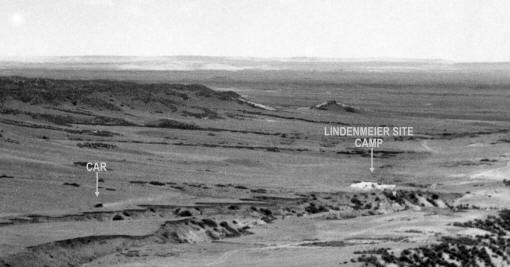
PHOTO TAKEN BY ED LOHR, LITHIC CASTING LAB COLLECTION OF IMAGES
CLICK ON PICTURE FOR LARGER IMAGE
LINDENMEIER SITE
NORTHERN COLORADO
This impressive picture of
"isolation" shows how the local terrain around the Lindenmeier site
looked in 1940. It was
taken by one of the excavators, Ed Lohr, who sent it to Lithic Casting Lab in 1990 (see
letter below). He wrote on the
back "11:45 a.m. August 4th or 5th, 1940." It shows the Lindenmeier
site's camp of tents on the right and a car with a dust trail on the
left that Ed wrote "might be Jim Grunack (spelling?)." |
|
|
The Lindenmeier site
is located in northern Colorado near the Wyoming border. More precisely,
it's located about midway in the center of the state in Larimer County
approximately 1.75 miles (2.8 km) south of the Wyoming state line. The
site is also located 28 miles north of Fort Collins, Colorado. |
|
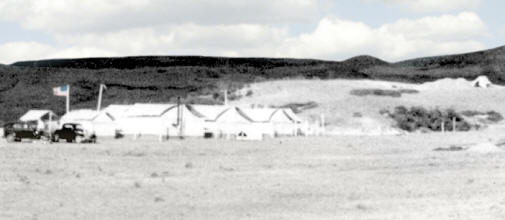
PHOTO TAKEN BY ED LOHR, LITHIC CASTING LAB COLLECTION OF IMAGES
CLICK ON PICTURE FOR COMPLETE IMAGE
THE LINDENMEIER SITE CAMP
NORTHERN COLORADO
This picture shows a small area of a photograph that was taken by Ed
Lohr in 1940. He sent it to Lithic Casting Lab in 1990. (see
letter below) He wrote on the
back "view facing west, Lindenmeier, August 17, 1940, the tents in
the background shows excavation area." Click on the picture to bring
up the full photograph. |
|
|
The Lindenmeier site was known to collectors for ten years
before Frank Roberts began his excavations there. The site was first
discovered in 1924 by three relic collectors, Judge C. Coffin, his son
A. Lynn Coffin, and C. K. Collins. Frank Roberts worked for the Bureau
of American Ethnology. That's probably why the American flag is seen
waving above the small tent city camp. The Lindenmeier project began
under his direction in 1934 and ended under his direction in 1940. |
|
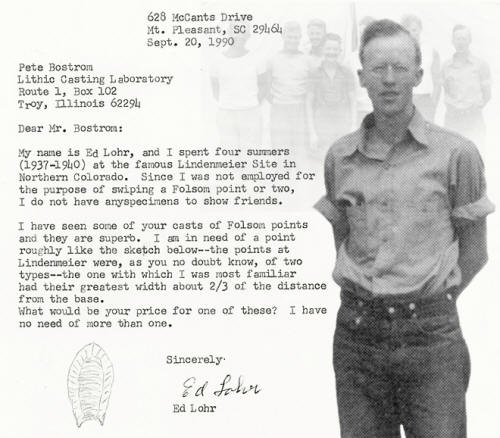
LETTER BY ED LOHR SENT TO PETE BOSTROM IN 1990. COMPUTER ADDED IMAGE
OF ED LOHR
FROM A PICTURE IN SMITHSONIAN PUBLICATION
"LINDENMEIER, 1934-1974,
CONCLUDING REPORT ON INVESTIGATIONS."
LETTER BY ED LOHR, A
LINDENMEIER
SITE EXCAVATION TEAM MEMBER
This letter, by Ed Lohr, was sent to Pete
Bostrom in 1990 for the purpose of acquiring a cast of a Folsom
point. The picture of him & other members of the excavation were
digitally added to the letter for this report. The picture was taken
when he was 27 years old, in 1939 standing in front of one of the Lindenmeier
camp tents. The letter shows that Ed had a since-of-humor: "Since I
was not employed for the purpose of swiping a Folsom point or two, I
do not have any specimens to show friends."
Ed Lohr worked under the direction of Frank Roberts at the
Lindenmeir site during the last four years of the excavations. There
were seven digging seasons at Lindenmeier beginning in 1934 and
ending in 1940. It's estimated that there were a total of 580 days
spent on the site with 31 men working there, along with director
Frank Roberts who worked for the Bureau of American Ethnology. |
|
|
Frank Roberts named
the Lindenmeier site after William Lindenmeier, Jr. who owned the horse
ranch and land where the site was located. The site is described as
being situated in an eroded valley near
an arroyo (dry gully).
Holliday and Mandel describe the area as being in an unusual valley
setting. They describe the valley as a low order tributary whose waters
eventually drain into the South Platte River. The valley is also laying
within the physical geological boundaries of the northern Colorado
Piedmont and the High Plains. |
|
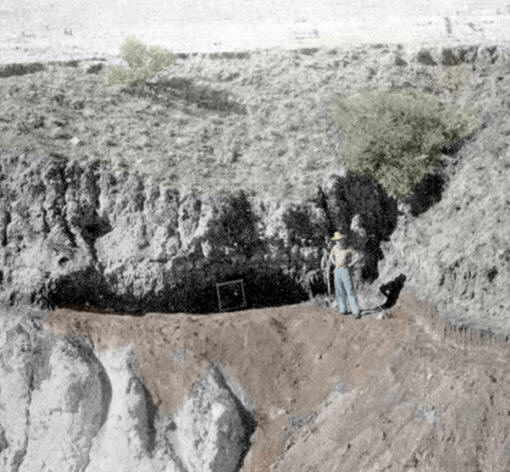
THIS IMAGE FROM
1935 SMITHSONIAN REPORT: A FOLSOM COMPLEX, "PRELIMINARY REPORT ON
INVESTIGATIONS AT THE LINDENMEIER SITE IN NORTHERN COLORADO"
CLICK ON PICTURE FOR LARGER IMAGE
FIRST 1934 EXCAVATION IN
THE ARROYO
LINDENMEIR SITE
NORTHERN COLORADO
This picture shows the first 1934
excavation where Frank Roberts opened up an area in the arroyo (dry
gully) where he discovered a deeply buried concentration of bones
and stone artifacts that proved to be a Folsom occupation level. |
|
|
The first excavation at
the Lindenmeier site began in 1934 in the arroyo that was later referred
to as the Big Pit. This is where Frank Roberts discovered a deeply
buried concentration of bones and stone artifacts that proved to be a
Folsom occupation level. The excavation then moved to an area above the
arroyo designated as area I. Area I is situated on the western portion
of the site. The workers excavated approximately 229 five foot squares, 25 ten foot squares and
an undetermined amount in the
"big pit" area during the first five years of the seven year excavation
project. |
|
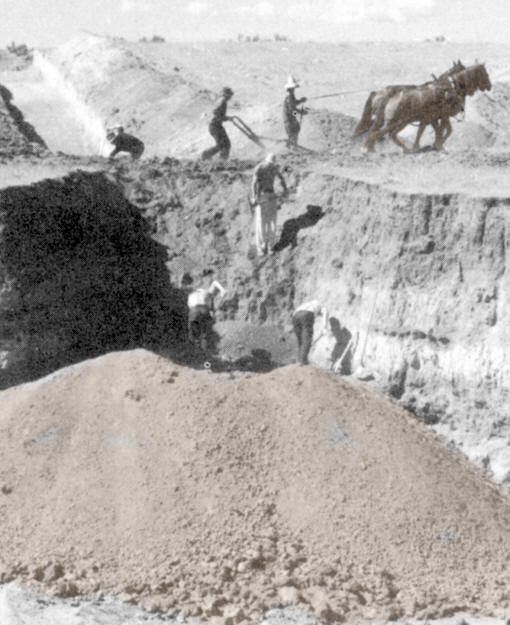
THIS IMAGE FROM SMITHSONIAN
REPORT: "LINDENMEIER, 1934-1974,
CONCLUDING REPORT ON INVESTIGATIONS."
CLICK ON PICTURE FOR LARGER IMAGE
EXCAVATION IN PROGRESS--1936
LINDENMEIER SITE
NORTHERN COLORADO
This picture shows quite a lot of activity
in an area called the Big Pit. This photo was taken sometime during
the third year of the seven year excavation project. Six people can
be seen working in the excavation. Roberts used horses to remove several feet of overburden above the Folsom level and again to
backfill the excavated areas. |
|
|
The other large area that
was excavated on the Lindenmeier site is designated as area II. Area II
was excavated during the last three years of the seven year excavation
project. It was situated 330 feet (100 m) east of the ten foot squares
located in area I. More than 165 five foot squares were excavated in area II. |
|
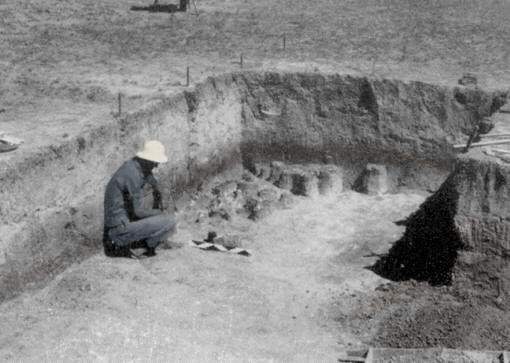
THIS IMAGE FROM THE
Annual Report Of The BOARD OF REGENTS Of The
Smithsonian
Institution, 1944, "THE NEW WORLD PALEO-INDIAN."
CLICK ON PICTURE FOR LARGER IMAGE
EXCAVATION SHOWING DARK
MIDDEN
LINDENMEIER SITE
NORTHERN COLORADO
This picture shows the dark midden layer in
an excavated wall where the Folsom horizon and
Paleo-Indian habitation level is located. The small pedestals of dirt probably
hold artifacts at the locations where they were found. |
|
|
The most important
discovery at Lindenmeier was a Folsom habitation component in the form
of a distinctively dark colored midden. This was found at varying depths
over a wide area. In fact, in some areas it was eroded to the surface.
The Folsom midden zone also eroded from the bank of the arroyo (dry
gully). These are the find spots that
enabled collectors to discover the site. The Folsom zone at Lindenmeier is generally
encapsulated under several feet of anciently deposited alluvial made of sand, clay and gravel.
A concentration of extinct animal bones and Folsom related stone
artifacts were found within the midden that proved the site was very
ancient. |
|

FOLSOM POINT
(EICHENBERGER CAST)
LINDENMEIER SITE
NORTHERN COLORADO
This
picture shows three views of a cast of a Folsom point that was
discovered on the Lindenmeier site. The cast was made sometime in the 1960's
or 70's by J. Allen Eichenberger. This is an excellent example of
the "classic" Folsom point that has wide and full flute
flake removals and fine pressure flaking along the edges. This point
(cast)
measures 1 13/16 inches (4.6 cm) long. |
|
|
Before
Lindenmeier, archaeologists were still skeptical that Folsom points were
ancient. But after Lindenmeier, archaeologists began to theorize various
ranges of dates. In 1944 Robert's wrote that these suggested dates vary
somewhere between 10,000 and 25,000 years ago. Bryan and Ray thought the
date should be closer to 25,000 years while other archaeologists thought
the date should be closer to 10,000 years. That's pretty good
guessing considering there was no radiocarbon dating at that time. In
fact radiocarbon technology didn't appear for another five years. The
most recently adjusted and published dates for the Lindenmeier site and
for other Folsom sites, such as Lipscomb, is between 12,900 and 11,700
years ago. |
|
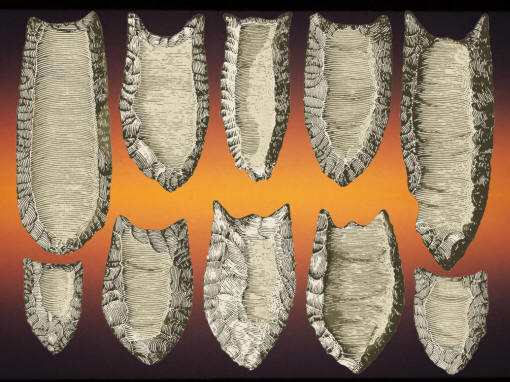
DRAWINGS FROM
SMITHSONIAN REPORT: "LINDENMEIER, 1934-1974,
CONCLUDING REPORT ON INVESTIGATIONS."
CLICK ON PICTURE FOR LARGER IMAGE
FOLSOM POINTS FROM AREA I
LINDENMEIER SITE
NORTHERN COLORADO
These drawings illustrate 10 of the
59 complete fluted Folsom points found on the Lindenmeier site. They
also illustrate some of the style variations that were caused from
breaking and resharpening. Some of the points have been re-pointed
from tip breaks. The different styles of bases may be a reflection
of several different people making them. Some of the bases are much
more concave than others and two of the points in the bottom row
still retain some of the original flute striking platform. These ten
Folsom points were recovered from a location on the site known as
area I. Area I is situated on the western portion of the site. The
workers excavated approximately 229 five foot squares, 25 ten foot squares and
an undetermined amount in the
"big pit" area during the first five years of the seven year excavation
project.
The Lindenmeier site produced 645 lanceolate projectile
points (Folsom fluted and unfluted points).
But 323 of these are described as preforms or parts of preforms so
there were closer to 322 "finished" fluted and unfluted Folsom
points found on the site. Of these, only 59 were complete fluted
points. Another 184 were fragments of fluted points and another 79
were complete or fragments of unfluted points. |
|
|
During Franks Robert's
seven year excavation project of the Lindenmeier site he had 31 full
time workers who took active parts, in different years. They excavated
more than 19,300 square feet (1800 square meters) during approximately
580 days spent in the field. The field notes total 1,557 pages. The
cataloged numbers for chipped stone artifacts total 5,478 and there were
46,380 waste flakes. |
|
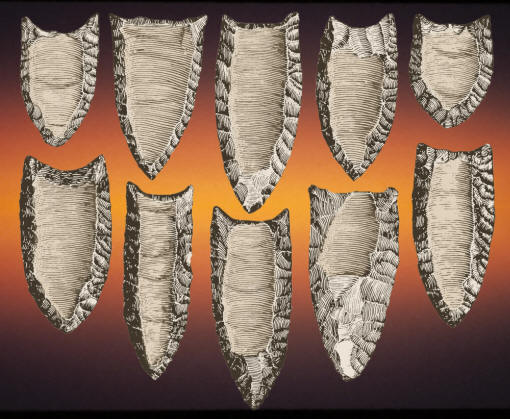
DRAWINGS FROM
SMITHSONIAN REPORT: "LINDENMEIER, 1934-1974,
CONCLUDING REPORT ON INVESTIGATIONS."
CLICK ON PICTURE FOR LARGER IMAGE
FOLSOM POINTS FROM AREA II
LINDENMEIER SITE
NORTHERN COLORADO
These ten fluted Folsom points were
recovered from area II on the Lindenmeier site. They illustrate
normal style variations within the Folsom type. For example, the
point in the top row, second from left, appears to have a repaired
base and the point on the far right appears to have been re-pointed
one or more times. Most of these points are fully fluted.
Area II was excavated during the last three years of the seven year
excavation project. It was located 330 feet (100 m) east of the ten
foot squares in area I. More than 165 five foot squares were dug in
area II. |
|
|
The Lindenmeier site produced 645 lanceolate projectile
points (Folsom fluted and unfluted points).
But 323 of these are described as preforms or parts of preforms so
there were closer to 322 "finished" fluted and unfluted Folsom
points found on the site. Of these, only 59 were complete fluted
points. Another 184 were fragments of fluted points and another 79
were complete or fragments of unfluted points. |
|
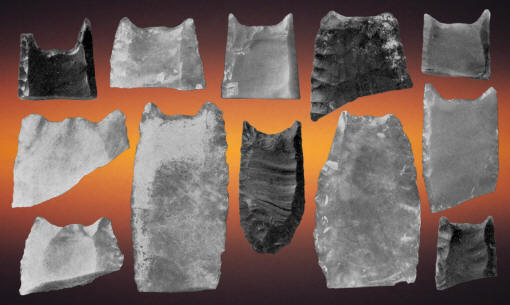
FROM 1935
SMITHSONIAN REPORT: "A FOLSOM COMPLEX, PRELIMINARY REPORT ON
INVESTIGATIONS AT THE LINDENMEIER SITE IN NORTHERN COLORADO
FOLSOM POINTS
LINDENMEIER SITE
NORTHERN COLORADO
These 12 Folsom
points were illustrated in Robert's first "Preliminary Report" on
the Lindenmeier site. They represent examples recovered from the
first year of excavation. All of these points were either broken
during use or during manufacture. Roberts illustrated the most
complete point, in the center, as a fragment of a Folsom point. It
appears to have been damaged on the point and repaired once then
damaged again. |
|
|
Complete unbroken fluted
Folsom points are rare. The artifacts found on the Lindenmeier site supports
this observation. Out of the 322 "finished" Folsom points that were
found, the excavation produced only 59 complete fluted Folsom points.
But many of these complete examples were extensively resharpened from
point impact damage and may actually have been discarded for longer
ones. It would appear that Folsom people believed it was easier to use a point for all its
worth by retrieving it and resharpening it than to make a new one. |
|
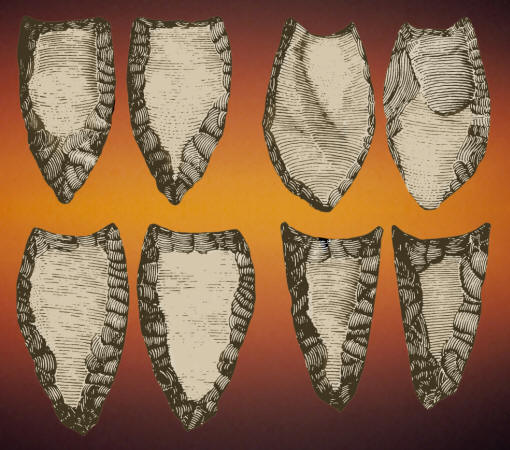
LINE DRAWING ILLUSTRATIONS FROM 1978
"Lindenmeier,
1934-1974,
Concluding Report On Investigations,"
Smithsonian Institution
CLICK ON PICTURE FOR LARGER IMAGE
FOLSOM POINTS MADE ON
FLAKES
"PSEODOFLUTED"
LINDENMEIER SITE
NORTHERN COLORADO
These drawings show both sides of four
points that were excavated from within the Folsom habitation level
on the Lindenmeier site. They illustrate the wide variation of
Folsom point design. All four of these points were made from edge
trimmed flakes. They are referred to as pseudofluted because what
appears to be flutes are actually the surfaces of the original flakes
from which they were made. Similar points can be found on much later Stone
Age sites in North America and other countries around the world. So
the technology that made these points was not very high. They could
have been made by anyone with only a minimal knowledge of
flintknapping. Maybe they were made by the younger members of the
tribal group. |
|
|
The Lindenmeier site
produced a wide range of different shapes of Folsom points. One of the
differences are the bases where the points were hafted to
the ends of spear or foreshafts. There are at least three different
basic patterns. Some Folsom points have deep concave bases, while others
are more shallow and more straight across the bottom of the concavity.
But the "classic" Folsom point has a base that still retains some of the
original striking platform that was used to drive off the flutes. These
small pressure trimmed projections in the center of the basal concavity
are unique to Folsom points. |
|

LINE DRAWING ILLUSTRATIONS FROM 1978
"Lindenmeier,
1934-1974,
Concluding Report On Investigations,"
Smithsonian Institution
FOLSOM POINT BASE DESIGNS
LINDENMEIER SITE
NORTHERN COLORADO
These three drawings of
Folsom bases show the basic design pattern that is seen on most of the
Folsom points that were found on the Lindenmeier site and from other
Folsom sites. Some Folsom points have deep concave bases, like the point
in the center, while others are more shallow and more straight across
the bottom of the concavity. But the "classic" Folsom has a base, like
the example on the right, that still retains some of its striking
platform that was used to drive off the flutes. |
|
|
Probably the
most unique form of Folsom point found on the Lindenmeier site are the
falsely fluted points that are referred to as
pseudofluted points. They are called pseudofluted because they only
have the appearance of being fluted. What appears to be flutes are only
the surfaces of the original flakes from which they were made. Similar
points can be found on much later Stone Age sites in North America and
around the world. So the technology that made them, which is simply edge
trimming a flake with pressure, was not very high. They could have been
made by anyone with only a minimal knowledge of flintknapping. It's
possible that they were made by the younger members of the tribal group. |
|

IMAGES FROM 1978
"Lindenmeier,
1934-1974, "Concluding
Report On Investigations,"
Smithsonian Institution
FOLSOM POINT LATE STAGE
PREFORMS
LINDENMEIER SITE
NORTHERN COLORADO
Both of these bifaces were found during the
excavation of the Lindenmeier site. They are late stage preforms
that were broken during the manufacturing process and discarded.
Preforms are some of the most important artifacts because they show
how the manufacturing process formed the final product, in this case
a Folsom point. |
|
|
The Lindenmeier site is also important for
the fact that it provided archaeologists with the first stone tool
manufacturing debris from a North American Paleo lithic industry. These
are the bits and pieces of stone that represent the processes of how
fluted points and other stone tools from this early period were made.
The site provided several examples of early and late stage Folsom point
preforms and channel flakes that were removed during the fluting
process. These types of artifacts must have been fascinating to the
first archaeologists who studied them. |
|
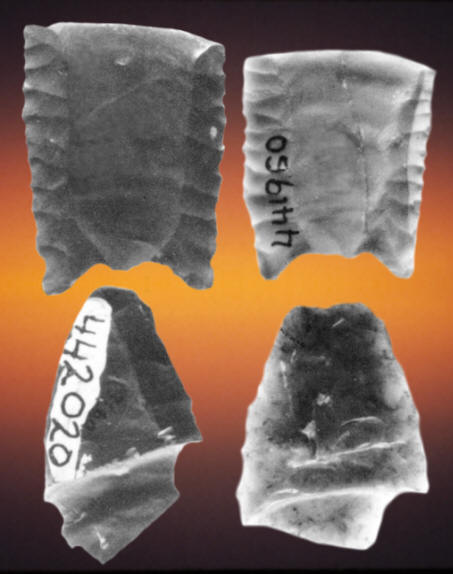
IMAGES FROM 1978
"Lindenmeier,
1934-1974, "Concluding
Report On Investigations,"
Smithsonian Institution
FOLSOM POINTS
BROKEN DURING MANUFACTURE
LINDENMEIER SITE
NORTHERN COLORADO
These four points were found on the
Lindenmeier site. They are all believed to have been broken during
the manufacturing process. In fact, they represent common break
patterns that occur during the fluting process. The two bases in the
top row show a continuous smooth downward curve of the flute flake
indicating how the point was broken. These are sometimes called
reverse hinge fractures. Instead of fracturing upward to the surface
the channel flake dives downward and breaks the point into two
pieces. The bottom two points broke as a result of this type of
break pattern. These types of fluting failures are also commonly
seen on Clovis sites. |
|
|
The Lindenmeier site is still the largest
excavated Folsom site. In 1961 it was designated a National Historic
Landmark and its been consider for a U.S. National Monument. So
after all the work of discovery, excavation, analysis and publishing the
site has rewritten history and its been honored in a way that will give
it some measure of protection going into the future. |
|
"REFERENCES"
1935, Roberts, Jr., Frank H. H., "A
Folsom Complex, Preliminary Report On Investigations At The Lindenmeier
Site In Northern Colorado."
1944, Roberts, Jr., Frank H. H., "The New World Paleo-Indian," The
Annual Report Of The Board Of Regents Of The
Smithsonian
Institution.
1957, Wormington, H. M., "Ancient Man In North America," p. 31.
1978, Wilmsen, Edwin N. & Roberts, Jr., Frank H. H.,
"Lindenmeier, 1934-1974, Concluding Report On Investigations."
2006, Holliday, Vance T. & Mandel, Rolfe D., "Geoarcheology Of The Plains,
Southwest, And Great Lakes," Handbook Of North American Indians,
Vol. 4 Environment, Origins, and Population (Smithsonian), p. 30.
1990 Personal Communication with Ed Lohr.
|
|
RECENT
LISTINGS HOME
ORDERING |